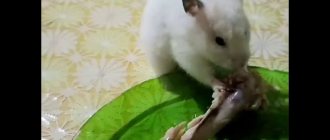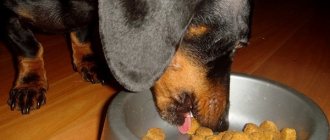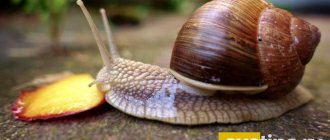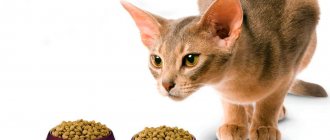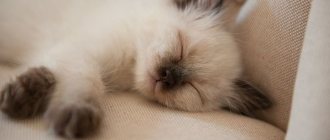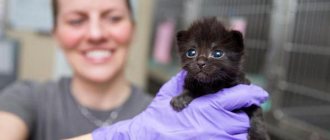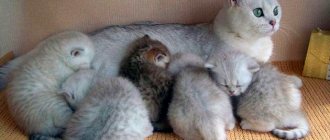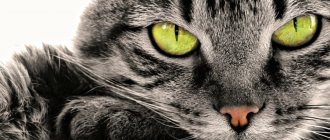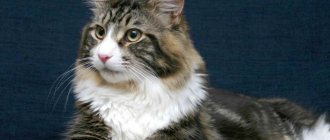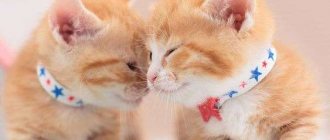Thanks to sterilization, you can not only avoid the appearance of unwanted offspring, but also prevent the development of cancer. The benefits of this operation outweigh the risks, which is why veterinarians strongly recommend it, even before the onset of the first heat.
It is important not to forget that such an intervention in the body requires a mandatory adjustment of the diet. Knowing what you can feed a sterilized cat at home, you can avoid its obesity and other common problems associated with hormonal changes.
Preoperative and postoperative diet
Before a full transition to a new diet, your pet will have to take a fasting day and go on a postoperative diet. With its help, she will be able to prepare her body for the upcoming changes.
Hunger strike before anesthesia
Preparation for general anesthesia includes mandatory refusal to eat 12 hours before surgery. This is necessary in order to prevent sudden attacks of vomiting. Otherwise, the unconscious animal may choke and suffer from aspiration pneumonia. For the same reason, it is recommended to remove the water, but a little later - 3 hours before surgery.
The first day after surgery
Feeding a sterilized cat on the first day after surgery is not provided. She won't have an appetite right after she wakes up, so don't even try to persuade her to eat a big lunch. Instead, offer some water to prevent dehydration.
Please note that only an awakened animal can be given water. Gently wet his lips with a damp cloth or pour a small amount of liquid directly into his mouth using a syringe or dropper. A bowl of water can be given only 3-4 hours after waking up, when the pet becomes more active.
First week after surgery
Food is introduced on the second day, but only when interest appears. If your pet categorically refuses it, you can keep her on a starvation diet for another 1-2 days. All this time she must drink water regularly, since dehydration is much more dangerous than a hunger strike.
All food served should be easily digestible and soft, and the size should be reduced to 1/3 of the normal serving. Focus on the following products:
- wet canned food and spider meat pieces;
- fermented milk products with low fat content;
- lean broths;
- slimy porridges cooked in water.
Harder foods can cause constipation, which can cause your stitches to split. You should also avoid extremely high and low temperatures that irritate the gastric mucosa.
Gradually increase your serving size to get back to normal within a week. Please note that it should not exceed 150 g per day.
Transition to normal food
They return to their usual diet about a week after surgery, but with minor adjustments. In addition to reducing the overall calorie content, you will have to give up a number of dishes familiar to the animal.
With dry feeding everything is much simpler. All standards can be viewed on the packaging, and the composition of such a product excludes the presence of substances harmful and useless to the body. The owner can only decide what kind of food to feed the cat after sterilization, since there are not so few options marked Sterilized.
Unwanted Products
Excessive amounts of magnesium and phosphorus provoke urolithiasis, so food with these microelements is limited. Useless and harmful “dishes” should not be eaten by any cat.
After sterilization, exclude from the diet:
- pollock, cod, and other types of fish are fed boiled no more than 2 times a month;
- sugar, sweets;
- pork;
- legumes;
- oatmeal, semolina;
- smoked meats and sausages;
- potato;
- garlic and onion;
- raw eggs.
Salt also provokes urolithiasis, so do not add salt to dishes.
Why do you need to review the diet of a sterilized cat?
Hormonal changes slow down metabolism, increasing the tendency to obesity. The animal becomes less active and more voracious, so the usual diet can cause rapid weight gain. Also, after the operation, the frequency of urination is reduced, which is fraught with stagnation of urine and subsequent formation of stones - that is, urolithiasis.
Causes of increased appetite
After surgery, cats need a diet. You can check with your veterinarian for the most beneficial diet for your pet.
In addition to the described consequences of sterilization, there is another one, which not all owners report - this is increased appetite. Previously, cats had developed two instincts: reproduction and saturation. After sterilization, the need to find a partner and raise offspring disappears, and the cat devotes all its energy to the remaining instinct. Cats often cannot restrain themselves in terms of food restriction, and will eat all the food, no matter how much there is in the bowl. And therefore, it is correct to feed a sterilized cat, limiting its diet (or rather, do not fill the bowl as soon as it is empty), otherwise there is a high risk that your cat will become obese, and this is fraught with additional health problems.
Natural cat nutrition after sterilization
In addition to reducing calories and reducing portion sizes, you will need to limit your fat intake in favor of foods enriched with proteins and slow carbohydrates. Knowing what sterilized cats can and cannot eat, you can easily create a new menu without harming the health of your pet.
Authorized Products
For convenience, all permitted products can be sorted by their predominant elements. The most important ones include:
- Squirrels
. Contained in meat (beef, chicken, rabbit, turkey), fish, offal, fermented milk products (yogurt, cottage cheese) and eggs. Such proteins are called animals. Unlike plant foods found in wheat, corn gluten and soybean meal, they are absorbed much faster in the stomach and do not overload the kidneys. Before serving, meat and offal must be thoroughly frozen and boiled to prevent infection by parasites.
- Carbohydrates
. Represented by cereals (buckwheat, oatmeal, rice), vegetables (zucchini, carrots, broccoli) and fruits (apples). Thanks to the high fiber content, they quickly induce a feeling of fullness. Effective in preventing constipation.
- Fats
. Marine fish are enriched with them, but they are not recommended for sterilized animals due to their high phosphorus content. Fish should be replaced with vegetable oils from pumpkin seeds, flax and corn, which have a similar composition.
The percentage ratio of these elements should be 52:12:36 according to the previously specified order. Don't be surprised that the smallest share comes from carbohydrates rather than fats. The thing is that it takes a lot of time to digest them, so in the wild cats receive them in a semi-digested form along with a swallowed rodent.
Prohibited Products
Difficult to digest foods high in fat, magnesium, phosphorus and salt are prohibited. It promotes obesity, causes constipation and provokes the development of urolithiasis.
When reviewing your diet, make sure to avoid feeding the following foods:
- river and sea fish;
- fatty fermented milk products and milk;
- pork;
- semolina, pearl barley and oatmeal;
- onion and garlic;
- raw eggs;
- potatoes and legumes.
It is also prohibited to feed the animal food from your table (smoked meats, sweets, canned food, baked goods, marinades). Human dishes contain large amounts of spices, salt and artificial additives that are intolerable to a cat's stomach.
Supplementation of vitamins from a veterinary pharmacy
Unlike ready-made food for sterilized cats, “natural” food is not able to provide the body with all the necessary elements. For this reason, some vitamins and minerals have to be replenished using ready-made complexes.
Please note that all vitamin and mineral complexes are administered only after consultation with a veterinarian. Independent choice of drugs can result in an overabundance of useful substances.
Healthy foods
Half of the diet is made up of proteins, the rest is made up of carbohydrates with fiber and fats.
It includes the following “dishes”:
Poultry, rabbit, beef. This is the basis of nutrition, it is given daily in boiled form, raw food is pre-frozen for 5 - 6 days. Before feeding, cut into pieces. Minced meat is allowed if you prepare it yourself; store-bought stuffing is too fatty. Fresh meat is not fed to avoid infection with helminths.
By-products: lung, kidneys, liver. They contain nutrients that are not found in muscle fibers; they are also frozen or boiled and included in the diet 2 times a week.
Meat broths. It is useful to accustom sterilized pets to this dish: they need an increased amount of liquid, but they are reluctant to drink water.
Vegetables: zucchini, carrots, pumpkin, cabbage. The boiled product is crushed into puree, the raw product is grated. If the pet refuses vegetables in their pure form, they are mixed with chopped meat or broth.
Fermented milk products up to 10% fat. Ryazhenka, sour cream, kefir, yogurt without fillers, and cheese are suitable.
Porridge: rice, barley, wheat, buckwheat. A teaspoon is added to meat or offal. If the animal refuses, then it is replaced with bran.
Vegetable oil, butter. Add 2-5 drops to food to maintain normal coat condition and improve stomach function.
It is useful to sprout greens from wheat grains, oats, or buy ready-made grass at a pet store. Vitamin and mineral supplements are given only on the recommendation of a veterinarian.
Feeding with industrial feed
As noted above, food for a sterilized cat must be marked Sterilized. It means that when creating these granules, the restructuring of hormonal levels was taken into account. This food has lower calorie content and eliminates the presence of harmful elements.
When choosing a brand, focus on its quality. Economy-class food is replete with useless plant components and mechanically separated meat, so it’s better to go for premium and holistic food.
Don't forget to study the composition. The quality of the product will be confirmed by:
- high meat content, determined by the location of this ingredient in 1st place;
- absence of flavor enhancers, flavorings and other dubious additives;
- the presence of L-carnitine, which accelerates metabolism, and L-lysine, which preserves muscle mass.
Please note that with natural feeding, 75% of the liquid enters the body from food. If your pet only eats dry food, then the granules give her no more than 10% of the daily moisture requirement.
To prevent dehydration of the body, make sure that the amount of water you drink exceeds the amount of “crackers” you eat by 2 times. The norm may decrease when feeding wet canned food, but should not fall below 20 ml per 1 kg of weight.
Place for eating
While eating, the cat should not be disturbed by anything or anyone - this will help avoid digestive problems.
It is also important to choose a suitable place for feeding your pet: quiet and calm enough so that no one disturbs it, in order to avoid absorbing food too quickly (in this case, there is a high probability that the cat will vomit the food). The place should also be clean, at a fairly large distance from the tray. You can use a special mat on which you will place the bowl. If there are many animals in the house, the bowls should be at a sufficient distance from each other. Well, if the pets don’t get along with each other, their feeding places need to be separated altogether. Feeding times should always be the same.
Feeding frequency and daily portion size
Having decided what food you will feed the sterilized cat, the owner will be faced with a change in the frequency of feedings and the size of the daily portion. Remember that dry granules cannot be mixed with “natural”. Such a diet can result in indigestion.
Adult animals are fed twice a day at certain times. The interval between feedings should be equal to eliminate the feeling of hunger.
If your pet does not eat enough and constantly wants to eat, divide its daily portion into more meals. After sterilization, she does not control the amount of food she eats and mindlessly swallows everything that is put in her bowl.
The average daily portion size depends on body weight. It is 30 g per 1 kg and is calculated individually. Be sure to monitor your pet’s weight and change the portion size up or down if necessary.
With a weight of 5-8 kg, you will need 150-250 g of feed per day, that is, the amount of recommended products will be as follows:
- meat and offal – 70-120 g;
- fermented milk products – 30-60 g;
- vegetables – 40-50 g;
- cereals – 10-20 g.
If your pet drinks little water, add light broths based on vegetables and meat to her diet. It is also necessary to mix a few drops of vegetable oil into the food. It has a positive effect on digestion and wool quality.
Changing your approach to feeding your cat
After sterilizing a pet, owners need to change their views on feeding it. First, you need to limit the amount of food you eat. It is a myth that the bowl should always be filled to the brim, and the cat itself knows how much it needs to eat. Therefore, you need to strictly observe the daily norm, giving it once a day or several feedings during the day. And don’t feel sorry for the little glutton if she “cries” next to an empty bowl. Once given a food reward, your cat will use the same techniques over and over again if he realizes they work.
Secondly, you need to monitor the physical condition of the animal. If the cat receives the recommended portion, and at the same time remains normal, then she has enough. If a standard portion causes weight gain, it must be reduced or the diet changed.
Visually it is not always possible to adequately assess the degree of fatness of an animal, so weighing is optimal. Only constant monitoring by the owners and individual adjustment of the amount of food will allow the cat to stay in shape.
How do you know that an animal gets everything it needs from food?
The correct feeding of a sterilized cat will be determined by its general health, appearance and weight. If your pet is alert and active, does not suffer from constipation or other digestive disorders, its coat looks well-groomed and shiny, and its weight is stable despite its good appetite, then you are doing everything right.
If at least one of these points is violated, the existing food supply must be reconsidered. Please consult your veterinarian for detailed recommendations.
Review of brands
Economy class food is not suitable: these are Friskas , NashaMarka , Kitikat , Whiskas . They contain 0.5% proteins, a lot of useless carbohydrates, and chemical flavor enhancers.
Manufacturers of premium and super premium products produce special lines for sterilized and neutered animals marked Sterilized . They are characterized by a reduced content of fat, phosphorus and magnesium.
Here are examples of special feeds in the mid-price category:
- Royal Canin. The diversity of the assortment is considered a plus. The manufacturer has developed 4 types of products: for kittens up to one year old, up to 7, over 7, and over 12 years old. In addition to dry granules, semi-liquid jellies, sauces, and pates are produced. Dehydrated poultry protein is listed at the top of the ingredient list, but its origin is not specified.
- Hill's. The company produces 3 varieties: dry granules for cats from 6 months to 6 years, over 6, and spiders. The first line of the list of ingredients is chicken, the composition includes L-carnitine, fat does not exceed 9%.
- 1st Choice. The products are made from fresh chicken. The food has a good composition of plant carbohydrates: it does not contain unhealthful corn and wheat, but contains brown rice, oat and barley kernels.
- ProPlan. In addition to dry food, the company produces canned and packaged food with poultry, ocean fish, and beef. The amount of protein reaches 41%, but wheat and corn gluten are present.
- Holistic products have a high protein content: from 40 to 75%, these are Now Natural, Acana, Go!, Orijen. There are no special dietary lines among them, but they are suitable for pets after sterilization. Holistic medications are given to animals with renal impairment with caution.
The pet is fed twice a day; granules should not be poured into the bowl uncontrollably. The daily dose is prescribed on the package, it is divided into 2 equal parts. Dry and wet food alternate, stick to products of the same brand.
There is no definitive “best” diet for a neutered cat. The main thing is to include foods that are healthy for the animal in a natural diet or to carefully select commercial food. If your pet eats with appetite, does not gain weight, does not suffer from illness and looks well-groomed, the diet is suitable.
Signs that food is suitable for your pet
- Eats with gusto.
- The coat is shiny and smooth (the cat is “shiny”) and does not fall out excessively.
- Stable digestion, regular stool.
- Healthy body condition.
Individuality cannot be denied to cats: every living organism may have its own needs and preferences. Some people like to crunch on crackers, others adore canned food, and still others eat only natural food.
There is no specific “best” food for sterilized cats. Sometimes the more expensive option turns out to be unsuitable, but the simple 1'st Choice provides a long, quiet life. You need to focus not on theory and other people’s opinions, but on your own impression. If your pet, eating Royal Canin, is healthy, does not gain weight and is happy with life, there is no need to switch it to a more “elite” food.
Not only to feed, but also to drink
Let's use our cat Sparkle as an example again. She is over 7 years old, feels well, has no signs of urolithiasis. We feed her with high-quality holistic food, but we only give her water purchased. And that's why. Several times during our vacation, we left a cat and a bag of food with our relatives, who gave their (and at the same time our) cat filtered tap water. The water in that area is quite hard, it even leaves a residue on the bowl.
After returning home, Sparkle was very reluctant to go to the toilet for a couple of days. She meowed and endured until the last. We were worried that something had happened to the kidneys. However, after a couple of days everything returned to normal. This happened three times, and we began to go through all the possible reasons. Finally we realized: since there are no changes in the diet, it means the problem is in the water. Now, when we go on vacation, we leave with the cat not only food, but also bottled water. We remind you once again: always pay attention to how much water your cat consumes! If he doesn’t drink well, change the water and/or buy a fountain. Lack of fluid will lead to urolithiasis much more likely than spay/neuter.
What is sterilization?
Let's understand the terminology: sterilization and castration. Many people believe that cats are castrated and cats are sterilized, but this is not true.
Castration is the removal of reproductive organs: in cats the uterus and ovaries, in cats the testicles.
Sterilization is another procedure in which a cat's fallopian tubes are tied, and males' spermatic ducts are ligated.
After sterilization, the animal continues to “walk”, mark, and in the case of a cat, ask for a cat.
If you care about your health. After such an operation, the cat will not suffer from hormonal imbalances. However, for some reason, the term “castration” scares owners, especially men. The widespread use of the term “sterilization” is nothing more than an attempt to avoid the wrong reaction of inexperienced owners.
When a cat reaches sexual maturity, the owners experience round-the-clock meowing, eyes full of sadness, rolling on the floor, walking with their butt up, and so on for 10–14 days. Sleepless nights, complaints from neighbors, a generously marked front door, if street cats have access to the entrance... stop! All these are your problems that you feel and see, but what happens to the animal? Something like this:
- In the first days of estrus, the cat will experience constant mood swings and nagging pain in the abdominal cavity.
- Further, the pain intensifies, the cat begins to roll on the floor. Some owners observe the cat's behavior with interest, believing that she likes it. Often this opinion is reinforced because the cat purrs. In fact, all these manipulations are undertaken by the cat to stop or dull the pain from spasms.
- The peak of estrus, intended for fertilization, passes, and is replaced by a hormonal imbalance - the system did not work as it should, all the hormones that prepare the cat’s body for motherhood are not needed and the body is forced to cope with this situation.
Have you read it, been horrified, and are already going for miracle pills like “Stop Heat”? Take your time, read on. So, the owner looks at the animal’s suffering and chooses one of four options:
- Submit to nature , breed a non-pedigreed (without pedigree) cat and acquire a new problem - kittens that no one wants. Statistically, even if you manage to place a new offspring, 70% of your graduates will suffer a very difficult fate. Simply put, they will join the ranks of homeless animals. Another point - one mating, one birth, one feeding - this is a wild overload of the body and a solution to the problem with estrus for a year at best (some cats can give birth 2 times a year). It's worth it?
- Tolerate the screams and wait for the cat to take a walk - of course, during the first heat, this is what you need to do in order to sterilize the cat later. If you decide for yourself and for the cat that you will endure it all its life, the pet is guaranteed to develop health problems, and its lifespan will be reduced by about 3 years. By the way, it is better to carry out the operation before the first heat.
- Giving pills is the most thoughtless and harmful decision an inexperienced owner can make. It is known that even after one dose of such drugs, cats can develop pathologies of the uterus and ovaries. Regular use of medicinal contraceptives leads to the development of chronic diseases of the reproductive system and oncology.
- Sterilize the cat.
The choice is yours! If your cat lives in the house as a companion and a member of the family, you do not plan to go to exhibitions and devote your life to the development of a certain breed - the reasonable choice is obvious.
It was already mentioned above that it is better to sterilize a cat before the onset of the first heat or 2-3 weeks after it (sometimes it is very difficult to predict the timing of the onset of heat). The operation should be performed only by a trusted doctor with a good reputation. The procedure is performed under anesthesia. An incision up to 2 cm long is made on the cat's side or along the linea alba (on the stomach). The incision site is preliminarily injected with local anesthesia and adrenaline (to reduce blood loss). Next, the uterus and ovaries are removed from the abdominal cavity, clamps are applied, and cutting is performed. If the operation is performed with a cautery, the incision site is immediately cauterized; using a scalpel, the surgeon (if necessary) stops the bleeding.
After removing the uterus and ovaries, three sutures are applied: deep, muscular and external. The incision site is treated with antiseptics, and a blanket is put on the cat. The procedure takes from 30 minutes to 2 hours, depending on the technique and instruments used.
After surgery, the cat quickly recovers from anesthesia, but remains lethargic for 18–24 hours. The pet will sleep a lot, your task is to make sure that it does not freeze (especially in winter), has access to water and does not show excessive activity. In the first days after sterilization, it is recommended to feed the cat only soft and liquid foods so that the pet does not have to strain the peritoneum during defecation. If the operation was performed efficiently, the suture will scar after 2–3 days. Sometimes the seam gets wet and ichor accumulates under the skin, but these problems are easily solved.
Important! After sterilization, the cat must wear a blanket or Elizabethan collar. The seam should remain dry and the cat should not lick it. When wearing a blanket, no additional dressings are required!
If the external suture is not applied with a self-absorbing thread, it is removed after 7–10 days. Many veterinarians insist on a course of antibiotics (3-5 days) after surgery. By and large, this measure is fair, but do not forget that antibiotics kill all bacteria, including friendly ones. Make sure your cat receives probiotics and only healthy, easily digestible food.
How does nutrition affect the body of a sterilized cat?
There is a myth that a neutered cat will definitely gain weight. Why a myth? Let's figure it out now. After sterilization, the animal’s sexual instinct decreases, and the released energy is redirected towards searching for food . Simply put, a neutered cat may eat out of boredom. If the animal eats according to a schedule and is balanced, weight gain is a priori impossible. So on what grounds did the myth appear? On the following, many owners:
- They leave the cat a full bowl of food, the pet eats when it wants, as much as it wants, and overeats.
- Do not play with the cat or provoke it into activity - most four-legged animals tend to lead an active lifestyle. There are exceptions - cats with a phlegmatic character.
- They believe that there is no need to communicate with a cat - cats are very social, without communication they fall into a state of stress, which is partially alleviated by gluttony.
Are these reasons related to sterilization? Of course not! With this lifestyle, any cat will gain weight. Prevention of obesity is:
- Weigh regularly ; keep in mind that after sterilization, a young and even adult pet may grow a little (bones, muscles).
- Feed your cat on a schedule , for example, morning and evening.
- Ban on treats from the table.
- Physical activity – if you don’t have time to play with your cat, make sure it has interactive toys, climbing posts, the ability to climb on high furniture, etc.
- Nutritional balance is an important aspect in feeding any animal. Cats a priori do not need carbohydrates; their body synthesizes energy from proteins. Rice or buckwheat is introduced into the cat’s diet as a filler (and not the main part). If your pet has an attack of gluttony, porridge is out of the question.
- Normal content of vitamins and microelements in food - deficiency and excess leads to metabolic disorders. In sterilized cats, excess minerals lead to the formation of edema.
Properly feeding a sterilized cat means monitoring your pet’s needs and not going to extremes. Some sources contain strict prohibitions on eating fish, but they are, to put it mildly, unfounded. Argument: fish contains a lot of minerals. Doesn't a cat need minerals? Of course they are necessary, but there must be moderation in everything. You can’t feed your cat fish every day (especially fatty ones), but sometimes you can eat a little.
Foods that need to be excluded from the diet
Sterilized pets need a special selection of their diet, as many changes occur in the body. First of all, a slow metabolism occurs. Energy requirements are reduced and appetite increases significantly, so it is necessary to carefully monitor her diet in order to avoid obesity. After sterilization, many pets experience a decrease in the frequency of urination, which exposes them to urolithiasis.
© shutterstock
That is why, never feed your cat such foods as:
- Fish, since phosphorus has a negative effect on the body
- Oatmeal contains large amounts of unwanted magnesium
- Semolina porridge is a source of carbohydrates
- Any dairy products whose fat content is above 10%, this can be sour cream or cream
- You should definitely forget about smoked, fried or pickled foods.
- Legumes and potatoes are high in calories and can cause diarrhea.
Never feed fresh meat to your cat, as this can cause not only the appearance of worms, but also protein intoxication. Do not try to use medications from your medicine cabinet to treat your pet, even if indigestion or bloating occurs.
